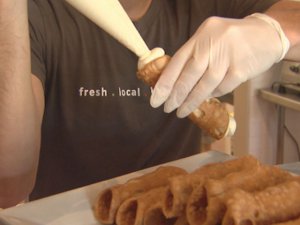You Will Judge a Restaurant by its Cover

There’s a little restaurant space in the central business district on a main artery that runs into downtown Denver. Restaurant brands have come and gone here; few have lasted more than a year. Looking at the latest inhabitant, I would not be surprised if its fate were the same. Judging this book by its cover, an underwhelming, transient experience is likely a guarantee.
Photo Credit: CBS
I go out to eat frequently, and when I do, I favor locally owned establishments full of charm and ambiance. Especially when approaching a new brand experience, I rely heavily on exterior appeal to lure me in. I look towards the restaurant name, logo, color, communication and messaging to gauge my willingness to walk through the door. With multiple signs of varying shapes and sizes, typefaces, colors and materials, the café at hand was no exception to my checklist. Though I drive by it daily, nothing about its exterior enticed me. I had never even considered venturing inside – until I scheduled a lunch meeting for work and my prospect wanted to dine at this very establishment.
Walking in, my initial opinion did not waiver. The bright neon green interior coupled with a deli case full of raw pastas and traditional Italian sweets made the place feel like a run of the mill specialty sandwich shop. It wasn’t until I picked up the menu on the counter that I realized this place might have some potential. The pastas: handmade, the meats and vegetables: locally sourced and organic, salads: inventive. They even offered gluten free pasta and a wine list. Needless to say, the story the menu told was vastly different than that of the experience I’d had thus far. As the story goes, I ate one of the best salads I’d ever had in my life. This surprising brand experience forced me to question just how many wonderful brands are out there that masquerade as disconnected experiences.
In branding, contrast can be appealing
The combinations of seemingly disconnected ideas grab your attention and may lead to trial. Whether it’s unexpected product placement by Old Spice, high-end fashion delivered at Target, or the concept of gourmet hot dogs, encounters with unexpected combinations provide a memorable connection between a person and a brand. In fact, some brands like Anthropologie have built contrast and seemingly disconnected combinations of ideas into its DNA; it is a characteristic that defines the experience no matter where you find the brand. Foodservice is no stranger to contrast. Pedestrian cupcakes peddled as high-end delicacies and food trucks offering complex flavors and unique ingredients are perfect exercises in contrast. But, why do they work so well while the new local café risks being missed by most Denver residents?
When leveraging unexpected combinations, the key to success is understanding and clarity. With a food truck or gourmet cupcakes, the name itself tells a story that customers can understand. Expectations are set, the contrast is defined, and barriers to trial are reduced at the outset. At the little café, I couldn’t appreciate the juxtaposition of bright modern communications with handmade, high-quality Italian food until I’d been through the entire dining experience. I didn’t understand the brand’s story without becoming a customer. As a result, how many foodies will miss it as well? The team at this brand has created a provocative exercise in contrast through this new restaurant experience, but it falls short in that it takes too much time and energy to truly understand it. Moral of the story: You have to make juxtaposition easy to understand if you really want to use it advantageously.



